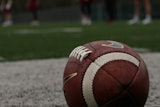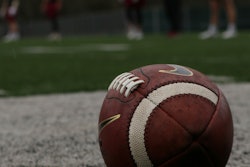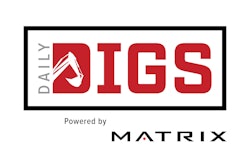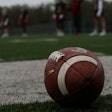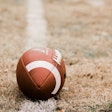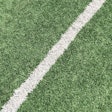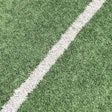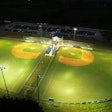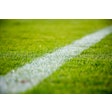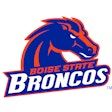From its introduction in the late '90s, the role of synthetic turf infill was to make synthetic turf play more like natural grass, providing more cushioning for the athlete's safety and performance.
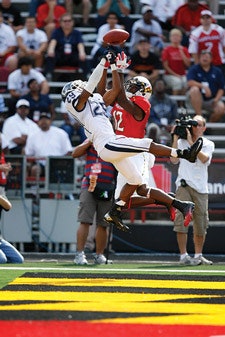
From its introduction in the late '90s, the role of synthetic turf infill was to make synthetic turf play more like natural grass, providing more cushioning for the athlete's safety and performance. Sand and crumb rubber proved effective in creating a more playable surface for athletes, and combining the two was even better. Most modern systems are comprised of at least two different substances, with the sand in the traditional sand and rubber combination providing a base to keep the rest of the mixture from dispersing or being displaced by athletes moving on the field.
Variations of the sand/rubber combination have dominated the market ever since, surviving the Great Crumb Rubber Scare of 2008 despite bans of the material at New York parks and playgrounds and in Los Angeles schools, but the search for alternatives began long before that. "As great as the product was and the fact that it represented a quantum leap from what synthetic turf had been, there were still things we could do to make the product better," says FieldTurf CEO Eric Daliere of the company's first infill system, which hit the market in 1994 and launched a new generation of synthetic turf.
For starters, heat absorption was still a major issue. Temperatures on typical synthetic turf systems utilizing rubber infill can reach as high as 170 degrees. "The infill material acts like an insulator and allows very little heat to be absorbed," explains Andrew McNitt, director of the Center for Sports Surface Research at Penn State. "All the heat is reflected back, and that's what makes those fields so hot."
McNitt says the focus of researchers remains squarely on a solution with real-world benefits. "We've been researching various ways to reduce the temperature of synthetic turf inexpensively for a number of years," he says. "If we have unlimited resources, we certainly can cool these fields, but that doesn't help a high school or recreation department. You need something that is inexpensive. You cannot double the price of synthetic turf fields and expect there to be great market share."
Which brings us to the current generation of synthetic turf, one poised to mitigate the issue of heat as it continues its evolution into a product with all the properties of natural grass. Limonta Sport, based in Bergamo, Italy (also known in the United States as GeoTurf), has used InfillPro Geo in all of its 11 fields constructed in the United States since 2008. Domo Sports Grass, based in Sint-Niklaas, Belgium, introduced its Naturafill infill to the European market last year, and Montreal-based FieldTurf debuted its first field with CoolPlay technology last fall at the University of Maryland and is rolling it out in full force this year.
All three manufacturers promise that these products will lower temperatures to a level more consistent with that of natural grass on a hot day, though there is still some difference. "Heat can be retained by two things; the fiber and the infill," explains Daliere. "Thus far, we've taken the heat-absorbing capacity of the infill out, but we still have the fiber, which is our next focus."
The material helping take the heat-absorbing capacity of the infill out of all three of these industry-changing products? Cork. Abundant and sustainable, its porous nature provides cushioning and is key to its heat-reduction capabilities. "It basically absorbs humidity and retains moisture, and then replicates the evaporative cycle of natural grass and soil," explains Domenic Carapella, managing director of Limonta Sport USA. As with natural grass, the heat of the sun causes the water retained in the cork to evaporate, taking some of the heat with it. "That's what keeps natural grass alive and healthy in the sun. The same with this turf."
FieldTurf's latest infill innovation, CoolPlay, replaces the top layer of its crumb rubber/silica sand blend with an exclusive cork material. It may seem like a small change, unless you're an athlete playing on a field with the new cooler infill, which is laboratory-tested to lower temperatures by 35 degrees versus traditional sand/rubber systems. And while FieldTurf's infill is billed as a cooling solution for outdoor fields, it comes with an added benefit of being able to withstand the heat indoors, boasting a Class-I fire rating. "We've taken our high-performance system, the same system used by the top NFL and college teams, and found a way to make it cooler," says Daliere. "We've found a way to maintain top-level performance but reduce the heat."
Other manufacturers are utilizing cork as the primary cushioning material, eschewing rubber altogether. A purely cork infill is one option, but the lightweight nature of the material becomes a detriment in such a system. "The cork washes away by itself and is really useless," explains Carapella. Limonta's infill utilizes coconut fiber, another organic material that adds to its natural-grass-like feel. "After we install it, we wet the field down, and that mingles the cork and coconut fibers even further. By the time it's done, it's like a wool blanket." As a result, the infill exhibits less splash or flyout under impact, allowing fields to retain more infill over time.
The similarity to natural grass can become a problem in hot, dry weather. "If the climate becomes hotter, with very little precipitation, you have to supplement it," says Carapella of the cork and coconut fiber blend, which, under typical weather conditions throughout most of the United States should not be an issue. The infill blend works best when kept at a 4 percent moisture level, a condition achieved naturally throughout most of the country via rain and humidity absorption. But under extreme heat and drought conditions like those found in the Southwest, additional watering may be needed. Carapella also recommends against the product's use in indoor environments for that reason. "You have a controlled environment where all the humidity is sucked out of the air. Like natural soil, the infill is not designed to dry out."
However, the same porous nature of the cork that allows it to absorb water makes it effective at absorbing impacts. According to ASTM International, a field's peak force of impact, or G-max rating, must not exceed 200; anything higher puts an athlete at risk of head injury. "We're testing over and over again," says Carapella, adding that Limonta aims for an infill G-max of between 80 and 90, well below industry standards but more comparable to a natural grass field. "Everybody loves natural grass and prefers to play on natural grass."
There are so many other factors that influence an infill's playability that choosing between proprietary systems is tricky. "We constantly continue to look at improving safety and playability," says McNitt. "What we find there is that it's very complicated to get your hands around all the moving components. There are some good studies out there that show the best shoe for a 90-pound player might be the most dangerous for a 300-pound player."
The other major issue at play in this latest round of turf innovation is sustainability. The average life of a synthetic turf field is eight to 10 years, after which the system generally needs to be replaced. Approximately 100 FieldTurf fields were replaced last year, and Daliere says that the industry is about to see a spike in replacements as the previous generation of installs reach the end of their usable lives. "We think synthetic turf is environmentally responsible from the start because of the water savings and engine use in mowing, but we've got to do something with all of this material coming back," he says. "We have 7,000 installed carpets, and that's a lot of recycled rubber and a lot of plastic. What do we do with the plastic, the backing and coating, and the fiber? The best opportunity for us is to find ways to use it in our own systems again."
The company has already found a way to recycle entire fields, but the cost makes it impractical, and so the search for alternative solutions continues. "There's a strong interest around sustainability that I think we're closing in on," says Daliere.
Cork is a step in that direction. "It's clean and recyclable," says Carapella. From the start, cork requires less processing than other infill. While Carapella says the company's infill cannot be reused in a new field installation, the all-organic materials don't have to go far to find a new home when a field is replaced. "When you're done with it, it doesn't have to go offsite. It can be used as a topdress in the surrounding natural fields."
As new synthetic turf projects are undertaken and existing fields come up for replacement, Daliere expects that a lot of users will be excited by the new infill's advantages. But by the time this next cycle of turf is ready for replacement in another decade, he hopes to have an even better product to offer. "The product makes sense for a lot of institutions that don't have it today," he says. "But we're constantly looking for what's next. There's more to be done."
Field Tests
Years of testing and tweaking components goes into creating a synthetic turf system that achieves the right balance of safety, performance and durability. Most of that initial work occurs far from the sports field, in a laboratory where real play and wear is simulated on a smaller scale. The FieldTurf Innovation & Performance Center opened in Montreal in 2010, part of the company's strategic plan to take the lead in advancing the industry. The company has also invested in a fiber manufacturing and research facility in Germany and a tufting and coating operation in Georgia. "The Innovation & Performance Center has allowed us to test products like never before," says FieldTurf's vice president of global marketing Darren Gill. "This laboratory was critical in the development of our recent systems."
The Innovation & Performance Center was intended to take control of the various elements that comprise a synthetic turf system and improve them, says Gill. "How can we make the system better for the athlete in terms of performance and safety, and at the same time, how can we improve the value to the owner?"
The facility, responsible for the company's latest fiber and infill innovations, Classic HD, Revolution and CoolPlay, operates with four full-time employees. In one part of the facility, individual yarns are tested for quality and durability, while another part of the facility is devoted to testing the entire system for playability and performance. Researchers test using different substrates, from most-often-used concrete to alternatives like asphalt and mixed gravel, with and without shock pads. Heat lamps and a freezer full of turf allow for testing under all conditions. "You name it, we test it," Gill says.
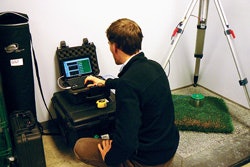
The most important and familiar test determines G-max (right). "G-max testing is obviously key and the most prominent test in North America," says FieldTurf director of innovation Luke Edwards. Testing involves dropping a weight equipped with sensors onto a sample of turf and using a computer to measure and record the force of impact. Three measurements are taken, and the second and third are averaged to determine the G-max. ASTM International's standards call for a rating of no more than 200 as a safety precaution, and while no lower limit is specified, softer isn't always better when it comes to performance. "Our testing goes beyond just G-max testing," says Gill. "We want to determine what happens to the athlete when he is running on the surface. We know that athletes get tired when they run on surfaces that are too soft."
Other tools are used to replicate the performance of the athlete. One device measures rotational traction, or how the sole of the athlete's shoe would interact with the surface as he or she cuts or pivots.
There's also a tool called, fittingly, the Advanced Artificial Athlete. "It's designed to replicate the human body, the average human impacting on the surface," says Edwards. "We can play around with different types of infill and underlayments and try to calibrate it so it has ideal performance for athletes."
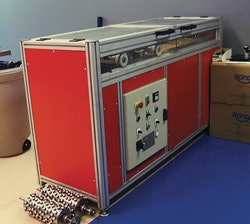
To test the performance of a system over time, samples are run back and forth through a Lisport Wear Machine (right). "It's the industry standard when it comes to wear," explains Gill. Ten thousand cycles through the Lisport is the equivalent of about five years of hard play, and simulations are run with units that represent both a cleated and non-cleated shoe. Continues Gill, "The flat sole is going to be more aggressive, and the cleat is going to create some spot wear."
After a sample has passed all of the lab tests, it's time to take it out into the field. "We're very conscious that this is all a closed environment," says Edwards. "While we test it here, once we get to a certain level of understanding, we take it to the field to test in situ to make sure it works." - E.A.














